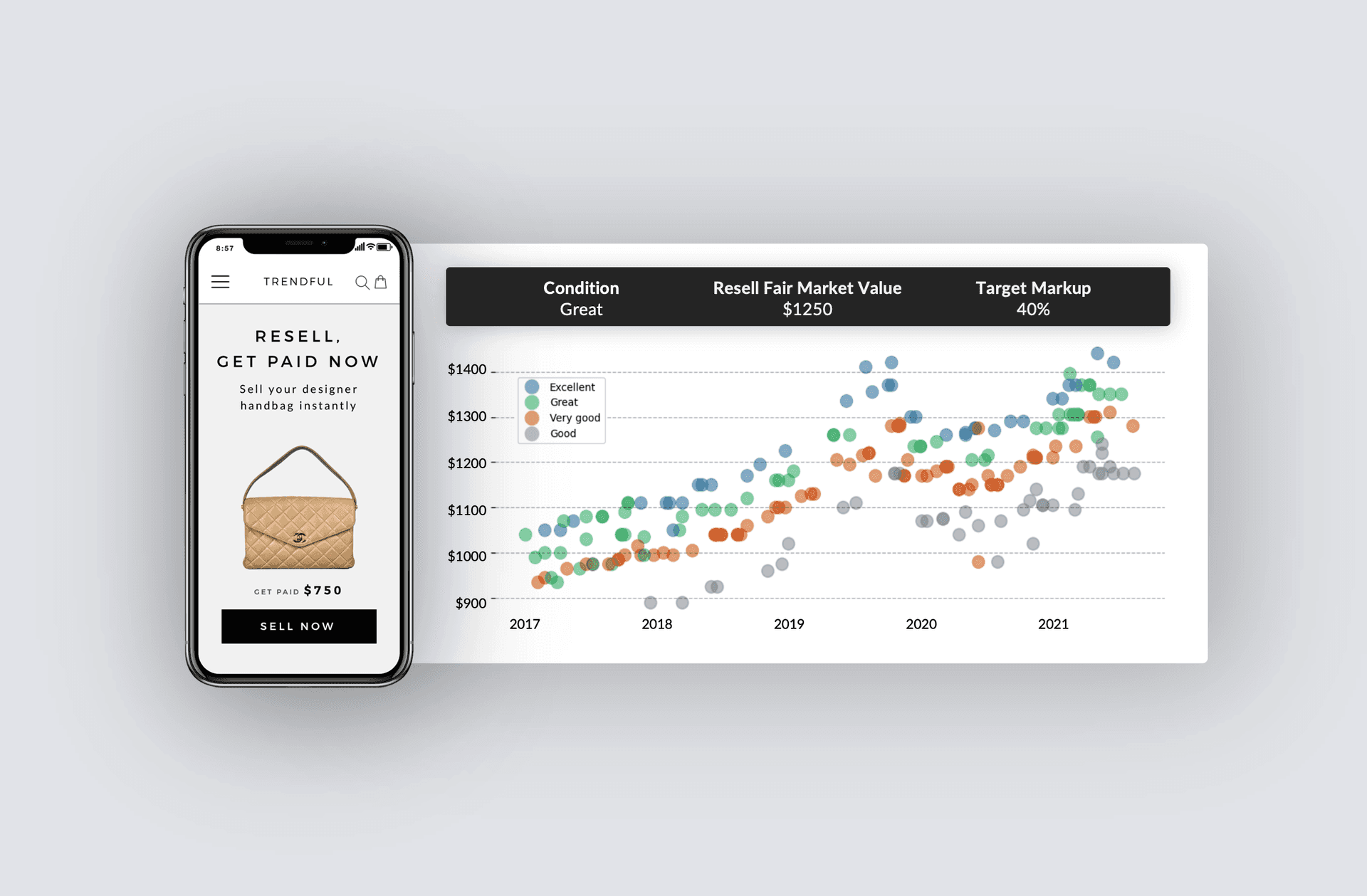
Recommerce - also known as resale commerce, refers to the unique business concept of selling previously used or owned items
There are many recommerce businesses with various business models, sizes, and niches. They include pawnshops, mom and pop shops, auction houses, estate sales, managed or P2P marketplaces. Despite their diversity, they all face the same challenges: evaluating the fair market value and acquiring pre-owned inventory.
You might be familiar with the B2B, B2C, and C2C business models, however recently, a new business model has become popular: C2B (customer-to-business). The C2B model is the reverse of the B2C model, customers produce services and/or products for companies. Most of the recommerce businesses rely on this model: they acquire inventory directly from their consumer, hence the interaction and money transactions occur from business to consumer.
Now, can you believe that there actually isn’t a technology out there that solves the main problems of pricing, shipping, and payments with this type of financial transaction: customer-to-business? Now there is, it is called Trendful.
What is Trendful?
Trendful is a service that enables secondary market companies to instantly evaluate the fair market value and acquire pre-owned inventory by automating pricing, shipping, and customer payouts.
Currently, the entire reselling process is inefficient and mainly relies on manual operations. At best, secondary market companies offer an archaic form or email option to buyout, consign, and/or trade-in goods from their customers. Then, businesses manually estimate the fair market value by visiting different secondhand websites and marketplaces. Searching and collecting multiple price points for a specific item is a time-consuming process, and even taking the time to do so, the resulting estimation may not be close to the real fair market value.
At Trendful we have created an interface for secondary market designer handbags that is easily integrated onto a business’s website. With the interface, the company can choose to offer their customers the ability to sell upfront, consign, and/or trade-in for store credit. On the frontend, customers can seamlessly use the interface to find their bag, describe the condition, receive an instant offer, and a shipping label. With our admin portal, our clients can manage their offers, shipping, and payments to customers. While on the backend, we have developed a unique pricing technology to collect, clean, and analyze data, and evaluate prices of secondhand designer handbags. For companies only interested in automating pricing and receiving product and industry insights, we will soon offer subscriptions to access our price database.
What is the rocket science?
We have developed smart algorithms to compute the fair market value accurately and instantly. Each week, we collect millions of data points for a collection of 35K handbags and 40 top designers. The data includes prices, condition, popularity, and other metrics we use to refine our algorithms.
Discover more about how we automate pricing in this article here.
Data Collection & Cleaning
Each week, we collect millions of data points from Google Shopping, TheRealReal, Rebag, Fashionphile, and other marketplaces made of businesses with various business models, sizes, and niches. From large marketplaces to small vendors and peer-to-peer marketplaces (P2P) to managed platforms, we get a full representation of the luxury fashion market in North America.
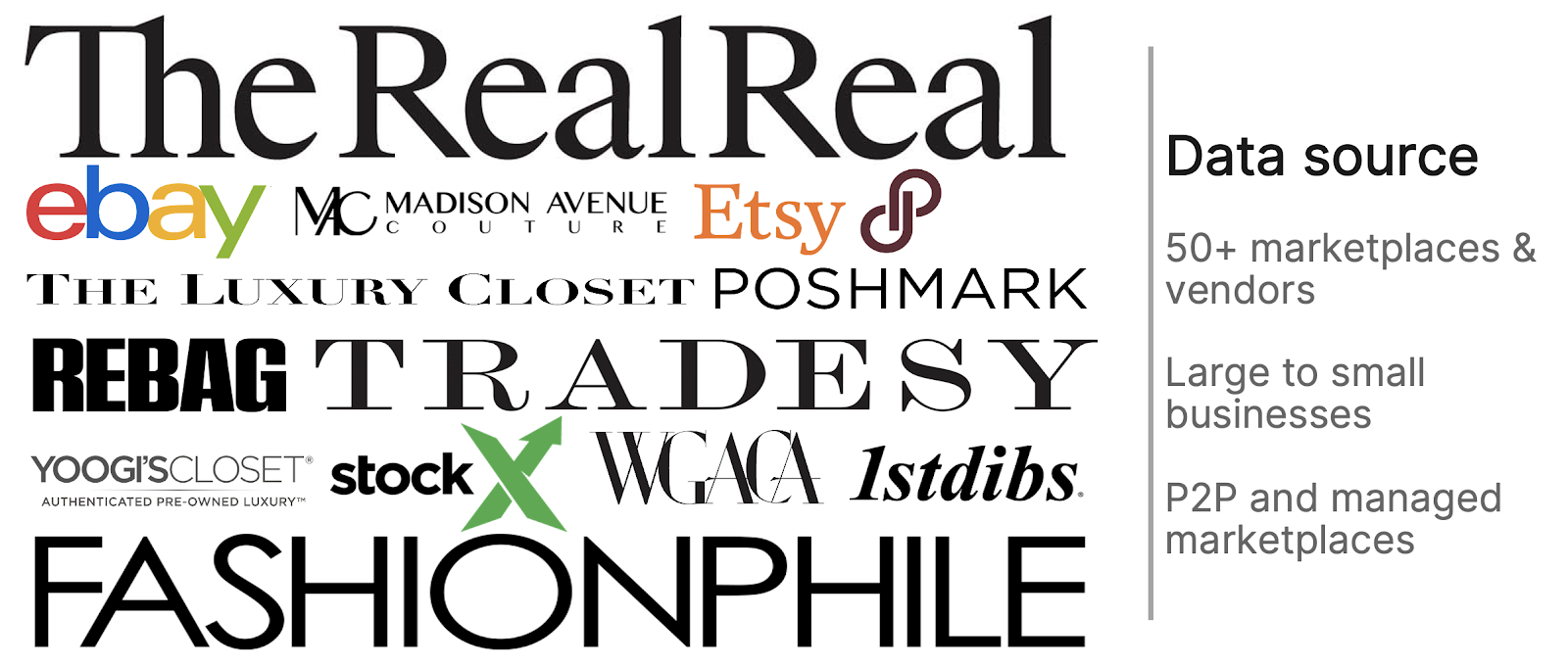
Because of the diversity of the data sources, the structure of the collected data varies from one source to another. We transform this data, depending on the source, to make it readable for further analysis.
The data includes prices, condition, popularity, and additional information we use to refine our algorithms: title, description, image, size, color, material, etc.
In parallel, we have developed a unique database, storing the unique product specifications of thousands of designer handbags. We are then able to recognize a product by its title, description, or images and are also able to translate any qualifying adjective or term into the right one.
How does Trendful make the magic happen?
We use natural language processing and image recognition that leverages machine learning to make smart algorithms specifically tailored for the luxury market. Machine learning is a branch of artificial intelligence that provides systems the ability to automatically learn and improve from experience without being explicitly programmed.
In other words, Trendful’s algorithms are smart and become smarter every day.
Let’s take an example:
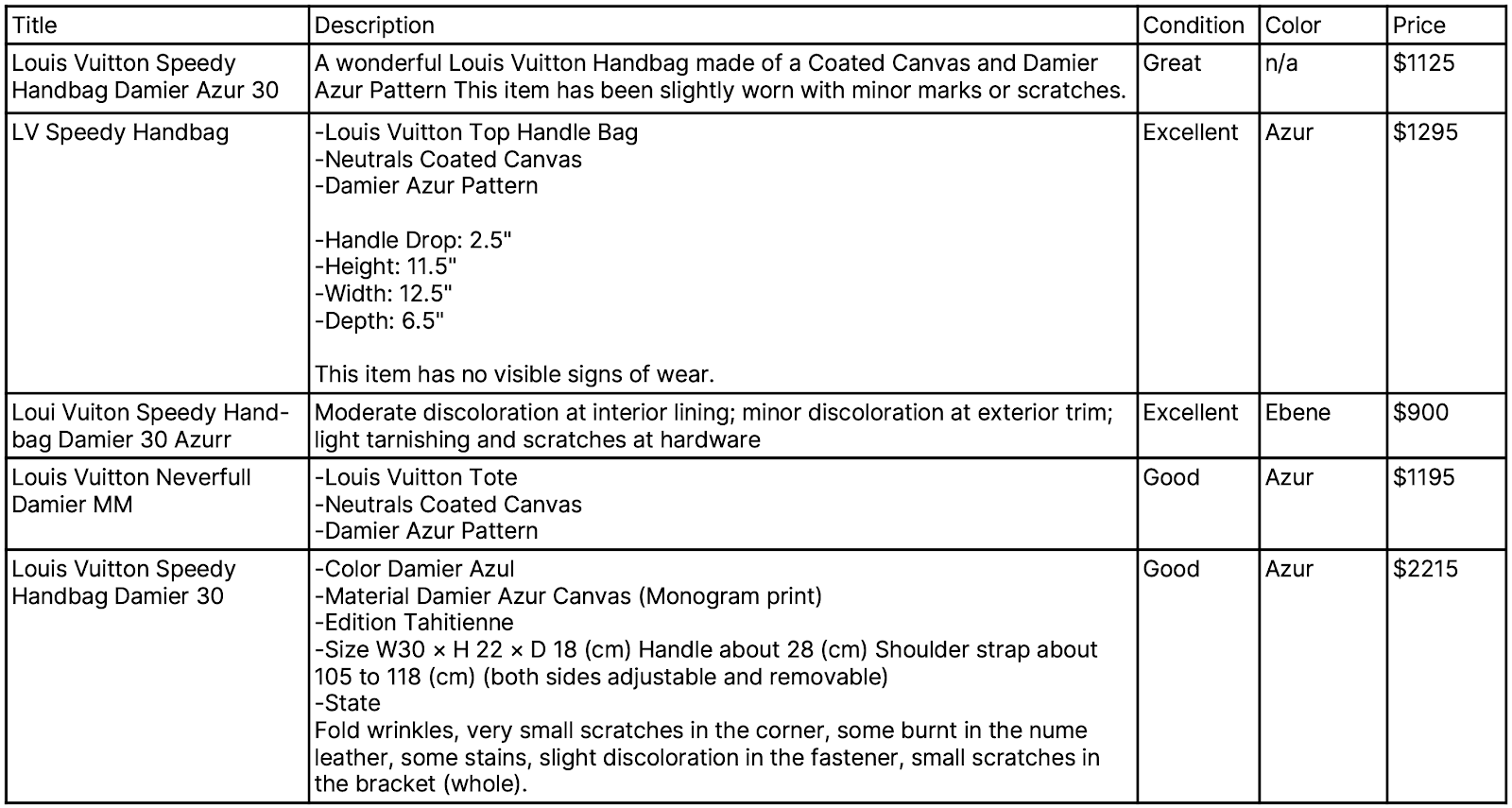 For the clarity of the explanation, we curated 5 lines of raw data for you. In reality, the raw data doesn’t look like that - things can get pretty ugly but our algorithms know how to deal with ugly.
For the clarity of the explanation, we curated 5 lines of raw data for you. In reality, the raw data doesn’t look like that - things can get pretty ugly but our algorithms know how to deal with ugly.
1. Read, extract and transform information into analyzable formats
As mentioned previously, by using natural language processing and image recognition, we are able to extract information such as the color, the size, the material, the style, and the condition.

2. Cross-check information
As the information is not always accurate nor precise, we cross-check it. In the example, using the item images and the text, we are able to determine that the condition and the color are incorrectly defined.

3. Cluster and identify models
After cleaning, extracting, and checking the data; we cluster the models together and identify them to give them an exact reference. And it doesn’t matter if the order of the words is not the same or if they are misspelled, our algorithms know how to read them.

4. Give reliability scores
Then, we measure the reliability of each data line. It depends on the data source (managed marketplaces are generally more reliable than peer-to-peer marketplaces) and the accuracy and precision of the data previously analyzed. Later on, this score will help to determine if a price point can be considered or not.
Finally, Trendful has developed methods to convert multiple raw data structures and formats into valuable data. Scikit-learn, Scikit-Image, SciPy, NLTK are some of the free and open-source Python libraries we use to make the magic happen.
We have also scaled these methods not only to work on a few dozen data points but on millions. Trendful uses them for not only collecting and cleaning the data but also analyzing it.
Data Analysis
After collecting and cleaning the data, the most popular items may be associated with hundreds of current price and condition data points. Trendful also has stored past data to analyze trends and identify outliers using statistical methods combined with machine learning. An outlier is a data point that differs significantly from the other observations.
As it is well known in the secondhand luxury market, items might gain, maintain or lose value over time. It is also referred to as asset appreciation or depreciation. In recent years, Louis Vuitton handbags have generally gained in value.
However, considering that Louis Vuitton is redesigning old models into new versions, these bags might reach a price threshold.* To illustrate how Trendful integrates trends to identify outliers, let’s take our previous example and represent the price points.**
*Note that some secondhand models might still be valued more than the primary market models.
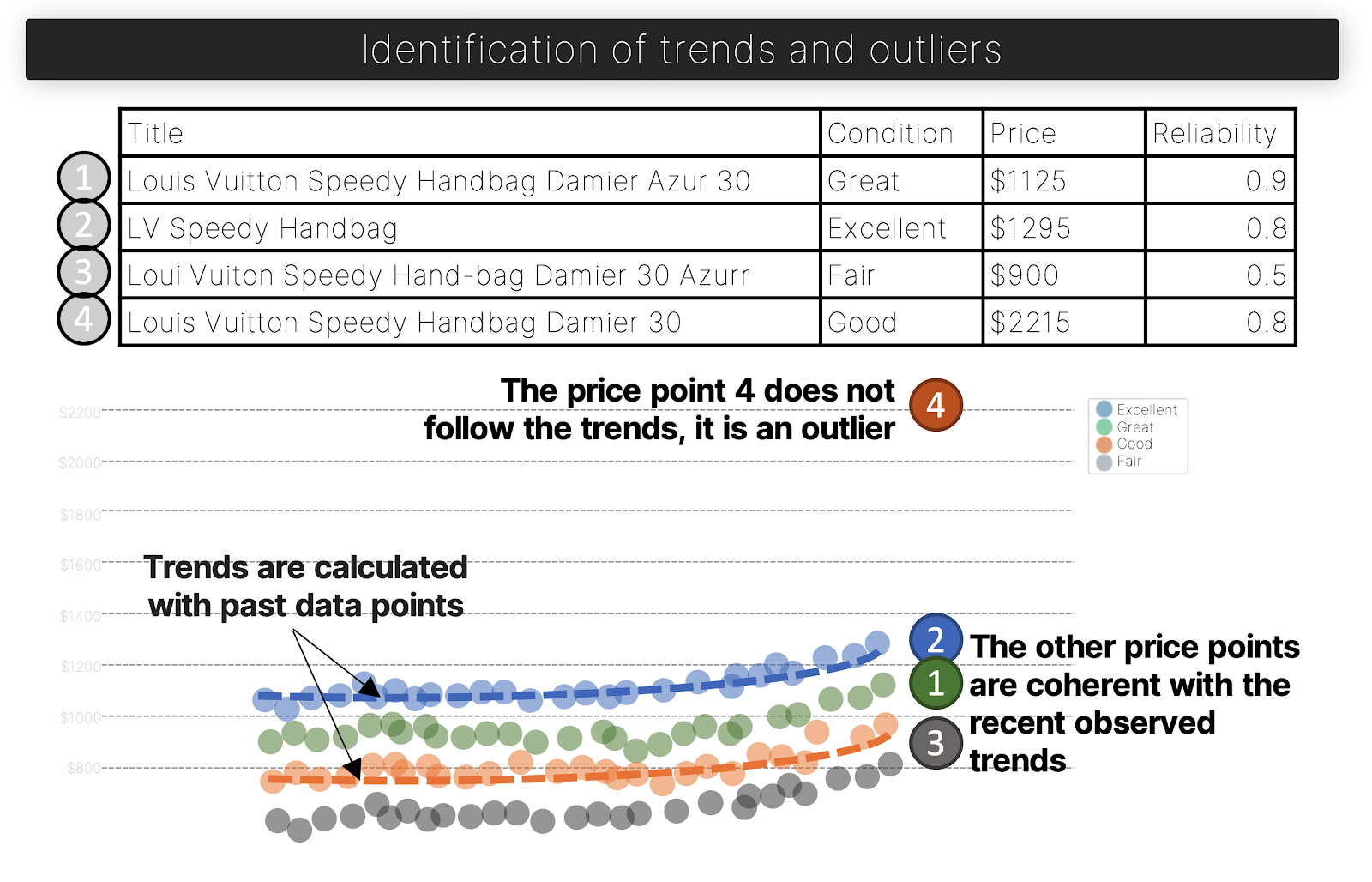
With the current data, we can identify the price point 4 as an outlier. Looking at the database, you can notice that it is not a Louis Vuitton Speedy Damier 30 Azur Handbag, but part of the Tahitienne collection. In reality, our algorithms work on larger datasets, which makes the identification of trends and outliers more accurate.
If in the future, the prices were to reach a threshold, the model would adjust by itself. The next time we analyze the data, it would take into consideration the new model and automatically detect new outliers that are abnormally distant from the new trend.
Our algorithms obviously take other parameters into consideration. First, trends are not necessarily linear but might be seasonal or impacted by events (i.e. Black Friday). Second, depending on the data source and data clarity, we have given a reliability score to each dataline that plays into the process of outlier identification.
After having analyzed new trends and removed outliers, we can compute current fair market values for many models. Considering that the price of an item depends on the condition, we compute the fair market value for each of the four conditions:
- Excellent
- Great
- Good
- Fair
During the data cleaning, we have reevaluated the condition of the item based on the condition information, the description and/or the images using natural language processing and image recognition. In addition to this step, we use trends once again, to understand how vendors describe the condition and price the item accordingly. Indeed, some vendors don’t make much distinction in price even though the condition is not the same while others do price more according to condition.
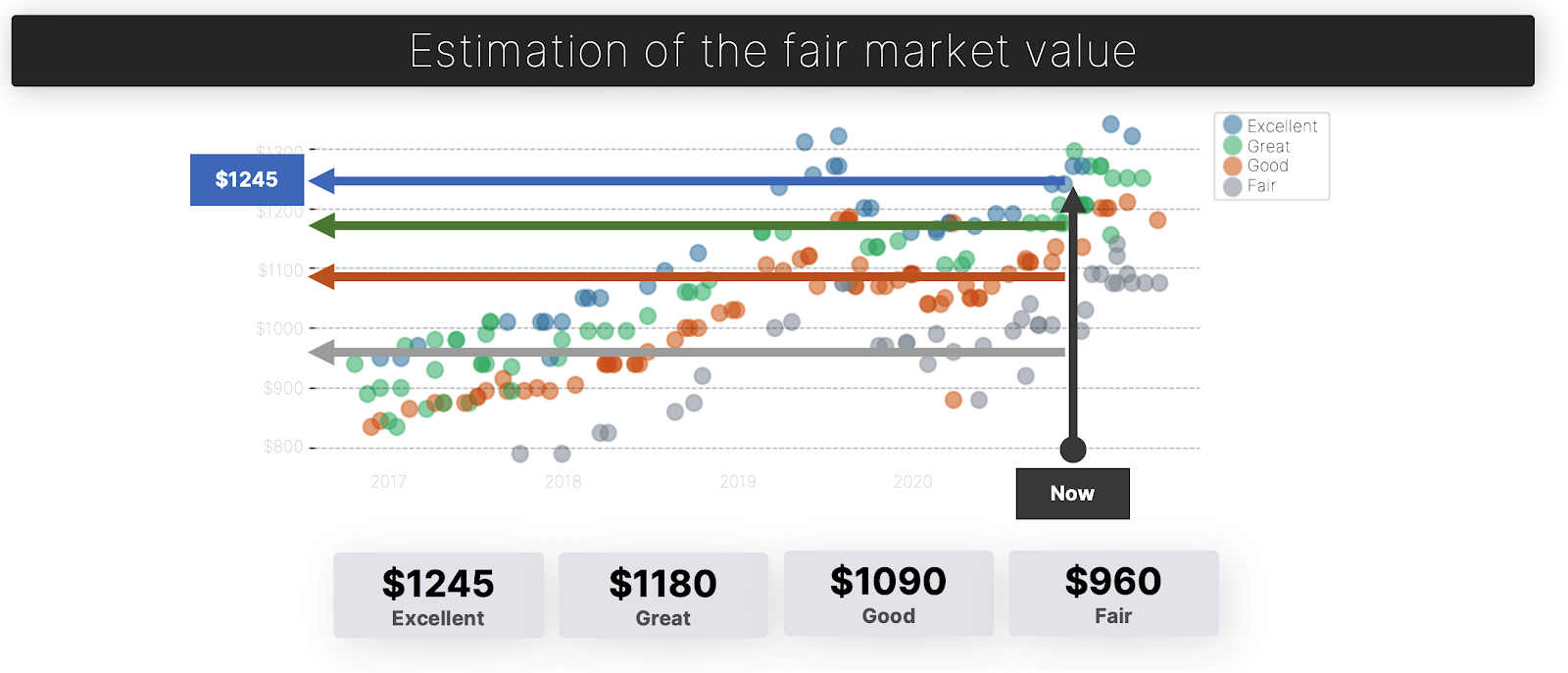
Despite the fact that the evaluation of the condition is subjective, our algorithms ensure that estimated fair market values fall in a range where most of the businesses will price their item at for this specific condition.
From the company perspective, we have made the resell interface so people have guidance in evaluating the condition of their handbag. It helps prevent a bad evaluation of the condition and allows us to give the right offer to their customers!
Conclusion
Congratulations, you have made it to the end! You are now more familiar with how Trendful powers luxury market recommerce businesses of all sizes. In a nutshell, we make the reselling process, or C2B transactions, easy for secondary market companies and their customers. Trendful plans on doing it not only for designer handbags, but also watches and jewelry and then other verticals.
As we collect data and our algorithms get smarter, we will not only compute the current fair market values but also predict them. Trendful’s mission is to help recommerce businesses in their daily operations but also to give visibility to the secondary and primary luxury market companies by delivering accurate and valuable insights about the products and the industry. Taking into consideration that the industry is growing tremendously, especially the secondary market, the field of opportunities is huge.
If you want to learn more contact us here!